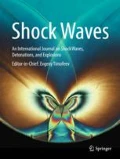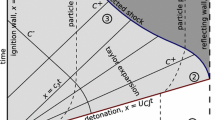Abstract
An experimental study of the detonation diffraction from 26- and 52-mm inner diameter tubes to cones of various angles α in stoichiometric acetylene/oxygen mixture allowed us to determine critical conditions for diffraction and to detail the mechanisms involved. All soot-foil records show that critical transmission is due to super-detonation propagating transversally in shocked gas before the decoupled flame front. However, at large cone angles (α > 40∘), super-detonation originates at the axis of the flow and propagates tangentially to the cone wall (this situation is close to detonation transmission to a space and a half-space). At smaller angles (i.e. α < 40∘), on the opposite, super-detonation originates at the cone wall and propagates toward the axis. In addition the soot plates often give some evidence that, during escape of detonation products from the tube, a Mach disk is formed at a distance of about one tube diameter from the tube exit. Numerical two-dimensional simulations of detonation diffraction favorably agree with the observations.
Similar content being viewed by others
References
Kogarko, S.M.: On the possibility of detonation of gaseous mixtures in conical tubes. Izvestia Akad. Nauk SSSR. Otdelenie Khimicheskikh Nauk. 4, 419–426 (1956)
Gubin, S.A., Kogarko, S.M., Mikhalkin, V.N.: Experimental studies into gaseous detonations in conical tubes. Fizika gorenia i vzryva 18(5), 111–117 (1982)
Borisov, A.A., Khomik, S.V., Mikhalkin, V.R., Saneev, E.V.: Critical energy of direct detonation initiation in gaseous mixtures. Progress in Astronautics and Aeronautics. Dynamics of Detonations and Explosions: Detonations. AIAA. New York 133, 142–155 (1989)
Thomas, G.O., Edwards, D.H., Lee, J.H., Knystautas, R., Moen, I.O., Wei, Y.M.: Detonation diffraction by divergent channels. Paper presented at the 10th ICDERS, pp. 144–154. Berkeley, California (1985)
Thomas, G.O., Williams, R.L.: Detonation interaction with wedges and bends. Shock Waves 11, 481–492 (2002)
Oran, E.S., Boris, J.P.: Numerical Simulation of Reactive Flow. Elsevier Science, pp. 1–601. Amsterdam (1987)
Khasainov, B., Priault, C., Presles, H.-N., Desbordes, D.: Influence d'un obstacle central sur la transmission d'une détonation d'un tube dans un grand volume. C. R. Acad. Sci. Paris, t. 329(Série II b), 1–7 (2001a)
Khasainov, B., Priault, C., Presles, H.-N., Desbordes, D.: On the mechanism of transition of self-sustained detonation from a tube to a half-space through an annular orifice with central obstacle. In: Proceedings of the 18th International Colloquium on the Dynamics of Explosions and Reactive Systems. ISBN# 0-9711740-0-8, Paper #96 (2001b)
Author information
Authors and Affiliations
Corresponding author
Additional information
Communicated by J.E. Shepherd
PACS 47.40.-x
Rights and permissions
About this article
Cite this article
Khasainov, B., Presles, HN., Desbordes, D. et al. Detonation diffraction from circular tubes to cones. Shock Waves 14, 187–192 (2005). https://doi.org/10.1007/s00193-005-0262-9
Received:
Accepted:
Published:
Issue Date:
DOI: https://doi.org/10.1007/s00193-005-0262-9




